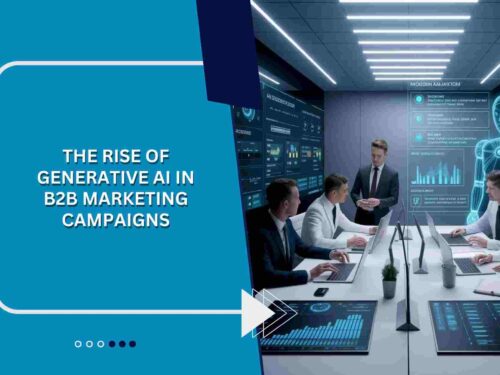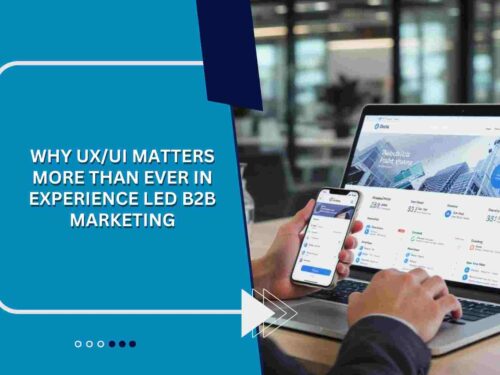In today’s hyper-competitive digital environment, demand generation is no longer about simply generating leads it’s about creating meaningful engagement that drives pipeline growth, revenue, and long-term customer relationships. For B2B businesses looking to scale rapidly, traditional marketing methods fall short. This is where AI-powered demand generation strategies come in, transforming how organizations identify, attract, and convert their ideal customers at scale.
Artificial intelligence has redefined demand generation by introducing automation, predictive analytics, real-time optimization, and intelligent personalization. These innovations empower B2B marketers to make smarter decisions, accelerate pipeline velocity, and optimize marketing spend while maintaining scalability and efficiency.
Let’s explore how AI-powered strategies can unlock new levels of B2B growth through advanced demand generation.
Understanding AI in the Context of B2B Demand Generation
Before diving into the strategies, it’s important to understand how AI fits into the demand generation ecosystem. AI encompasses technologies such as machine learning, natural language processing, predictive analytics, and automation, all of which can be integrated into various stages of the B2B marketing funnel.
From identifying intent signals and scoring leads to crafting personalized content and optimizing ad spend, AI plays a pivotal role in every phase of demand generation. This transformation enables marketers to go beyond assumptions and rely on data-driven insights for smarter outreach.
Strategy 1: Predictive Lead Scoring for Prioritized Outreach
One of the most impactful uses of AI in demand generation is predictive lead scoring. Unlike traditional scoring models that rely on static rules, AI-based systems analyze vast datasets to forecast which leads are most likely to convert.
AI examines behavioral patterns, firmographics, website activity, past purchases, and CRM data to assign dynamic scores. This allows B2B marketers and sales teams to focus their efforts on high-intent leads, increasing conversion rates and reducing the sales cycle.
By integrating predictive scoring into your demand generation strategy, you ensure resources are allocated efficiently, driving faster and more scalable growth.
Strategy 2: Hyper-Personalization Through AI-Driven Content
Demand generation is only effective when the message resonates with the audience. AI enhances content personalization by leveraging machine learning to deliver the right message, to the right audience, at the right time.
AI tools analyze user behavior, search history, job titles, and industry-specific needs to create tailored experiences across email, landing pages, and advertisements. For example, AI can dynamically generate personalized subject lines and product recommendations based on an individual’s past interactions.
This level of personalization significantly increases engagement and trust both critical for successful demand generation in B2B environments.
Strategy 3: AI-Enabled Intent Data Analysis
Intent data is a goldmine for B2B marketers. It reveals which companies are actively researching solutions related to your offering. AI tools can analyze third-party and first-party intent signals to uncover buying patterns in real time.
By applying AI to intent data, marketers can identify in-market accounts even before they reach out. This proactive approach empowers demand generation strategies by targeting prospects who are further along in the buyer journey.
When combined with account-based marketing, AI-powered intent analysis becomes a powerful mechanism for scaling outreach to the most relevant prospects.
Strategy 4: Chatbots and Conversational AI for Lead Engagement
AI-powered chatbots are transforming real-time engagement across websites and landing pages. These bots qualify leads, answer FAQs, book meetings, and guide users through the buyer journey without human intervention.
In the context of demand generation, conversational AI accelerates lead nurturing and reduces friction in the conversion process. By delivering immediate value to visitors and collecting valuable insights during interactions, chatbots create a smoother and more scalable lead flow.
Chatbots also ensure 24/7 availability, a critical asset for global B2B brands aiming to capture demand across different time zones.
Strategy 5: AI-Driven Email Campaign Optimization
Email marketing remains a cornerstone of demand generation, and AI is making it more intelligent and efficient. AI tools can analyze historical campaign data to identify optimal send times, craft better subject lines, and segment audiences more effectively.
Additionally, AI can A/B test multiple versions of email content in real-time, automatically selecting the highest-performing variation. It can even recommend personalized content blocks based on a recipient’s behavior, improving open and click-through rates.
With AI, email campaigns move from guesswork to precision, enhancing their role in a scalable demand generation strategy.
Strategy 6: Automated Content Creation with Generative AI
Creating high-volume content for demand generation is time-consuming. Generative AI tools like ChatGPT, Jasper, and Writesonic can automate content production, generating blogs, whitepapers, ads, and landing pages tailored to your audience segments.
This doesn’t just save time it allows for scalable demand generation campaigns that continuously produce fresh and relevant content to engage prospects at each funnel stage.
By combining generative AI with SEO tools and analytics platforms, B2B marketers can optimize content performance while staying consistent in brand voice and message.
Strategy 7: AI-Powered Ad Targeting and Spend Optimization
Paid media is a key channel in demand generation, but without precision, it becomes expensive. AI algorithms optimize ad performance by analyzing vast amounts of data in real time, adjusting bids, creative, and targeting strategies to maximize ROI.
Platforms like Google Ads, LinkedIn, and Programmatic Ads use AI to predict which users are most likely to engage and convert. These platforms can also retarget based on previous actions, creating highly contextual experiences that nurture demand.
AI-driven optimization ensures your paid media campaigns continuously scale without budget waste, making it a vital pillar of your B2B demand generation strategy.
Strategy 8: Real-Time Analytics and Adaptive Campaigns
Demand generation must be agile to keep up with fast-changing buyer behavior. AI-powered analytics platforms provide real-time campaign insights that allow marketers to make adjustments on the fly.
With predictive and prescriptive analytics, AI can recommend next-best actions, such as shifting budget allocation, adjusting messaging, or refining targeting criteria. This enables campaigns to adapt in real-time based on audience response, ensuring consistent performance and scalability.
AI-powered dashboards also consolidate cross-channel data, providing a unified view of campaign effectiveness across email, social, web, and ads.
Strategy 9: Intelligent Lead Nurturing and Drip Sequences
AI enhances lead nurturing by customizing drip sequences based on where a lead is in the funnel. Instead of a generic journey, AI tailors content delivery based on behavior, engagement, and preferences.
For example, a lead who downloaded a whitepaper may be served a case study next, followed by an invitation to a product demo. AI ensures the journey is logical and personalized, making the demand generation process more efficient and scalable.
These intelligent workflows keep leads engaged until they are ready to speak with sales maximizing pipeline quality and minimizing manual effort.
Strategy 10: AI Integration with CRM and Marketing Automation
A scalable demand generation strategy must seamlessly integrate with CRM and marketing automation platforms. AI tools enhance these platforms by auto-enriching contact records, scoring accounts, forecasting sales opportunities, and suggesting optimal follow-up actions.
By embedding AI within tools like Salesforce, HubSpot, or Marketo, marketers can orchestrate end-to-end demand generation workflows that operate with minimal manual input. This not only saves time but also ensures data consistency and more accurate attribution.
CRM-integrated AI also helps predict churn and upsell opportunities, adding value beyond lead acquisition.
Strategy 11: AI-Enhanced Video Marketing for Demand Generation
Video has become a powerful tool in B2B demand generation. AI tools help create and optimize video content by analyzing engagement data, recommending edits, or generating video scripts based on input prompts.
Platforms like Synthesia and Pictory use AI to turn text into professional-grade videos at scale. These can be used in email, landing pages, social media, and ad campaigns to boost engagement and nurture leads more effectively.
Incorporating AI-powered video marketing into your strategy provides a scalable way to connect with decision-makers visually and emotionally.
Strategy 12: AI-Powered ABM for Targeted Demand Generation
Account-Based Marketing (ABM) is a proven demand generation strategy in the B2B world. AI supercharges ABM by identifying target accounts, delivering personalized messaging, and tracking engagement across channels.
By combining AI with ABM platforms like Demandbase or Terminus, marketers can execute hyper-targeted campaigns that scale without sacrificing personalization. AI also helps uncover new lookalike accounts and surfaces insights to refine ABM strategies over time.
This intelligent approach drives higher-quality pipeline from the accounts most likely to convert, amplifying your demand generation results.
Strategy 13: Voice Search and AI-Powered SEO
As voice search becomes more common in B2B research, AI tools can optimize demand generation content for natural language queries. AI-enhanced SEO platforms analyze keyword trends, competitor performance, and search intent to inform content strategy.
AI can also identify content gaps and suggest topic clusters that align with your audience’s needs. This ensures your demand generation content ranks higher in search results, increasing organic traffic and capturing demand earlier in the buyer journey.
Optimizing for voice and AI-driven search behavior is essential for staying competitive and scalable in modern B2B marketing.
Strategy 14: AI-Backed Data Cleansing for Smarter Demand Generation
Data quality is foundational to effective demand generation. AI helps Fcleanse, enrich, and normalize data across marketing systems. This includes removing duplicates, correcting formatting errors, and appending missing firmographic or contact information.
Clean data ensures better segmentation, more accurate lead scoring, and higher engagement. By maintaining data hygiene with AI, B2B companies can confidently scale their demand generation campaigns without the drag of bad data.
It also enables better personalization, campaign targeting, and reporting crucial for driving continuous growth.
Let the experts at Acceligize help you build intelligent, scalable, and data-driven demand generation campaigns that fuel predictable pipeline growth.




